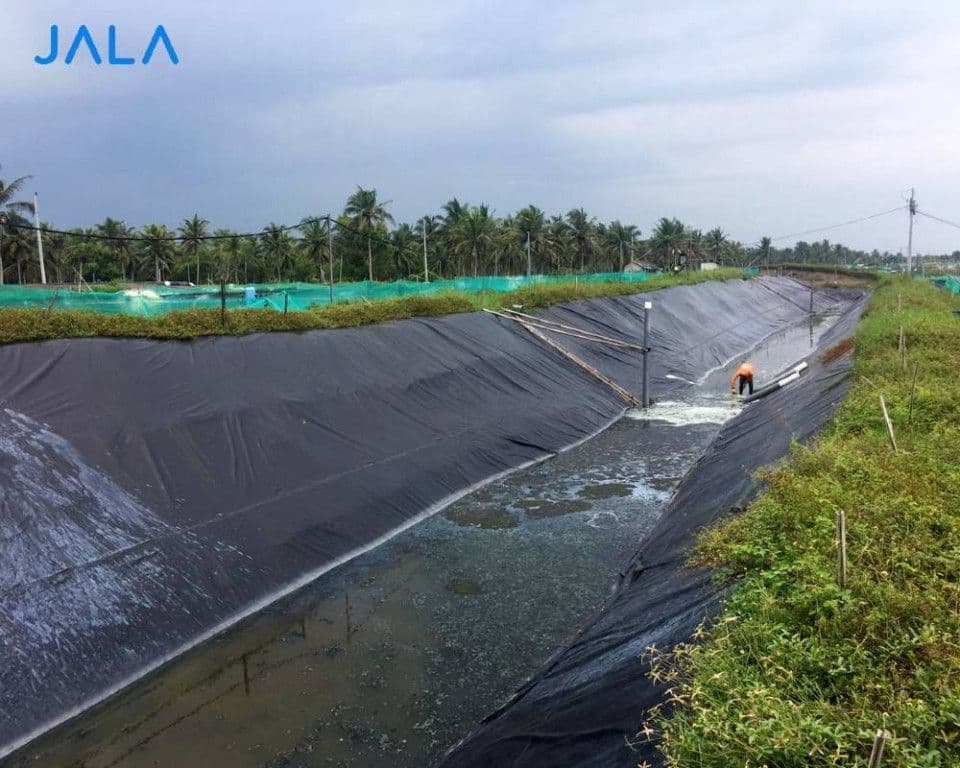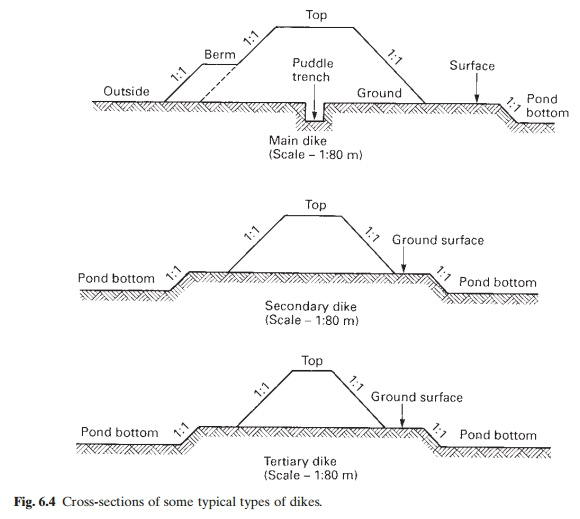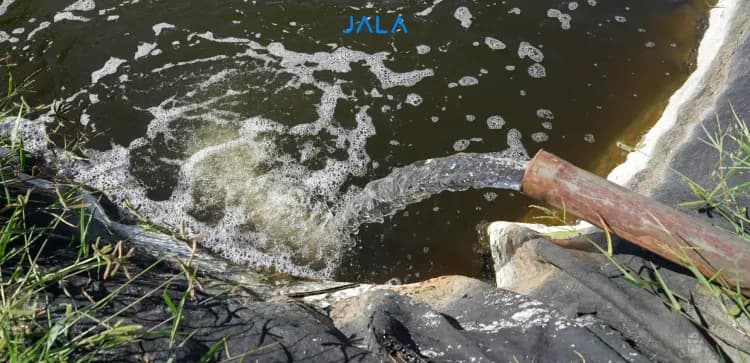
One of the essential factors that support the success of shrimp farming is the availability of adequate facilities and infrastructure. Among these, one important facility in the pond is the dike. A pond dike is a wall or dyke that functions as a separator between the pond area and the surrounding environment, such as seawater, rivers, and marshy areas. Pond dikes are typically constructed using locally sourced soil, rocks, or other materials suitable for the geographical conditions of the area.
Functions of Dikes in Shrimp Ponds
Pond dikes serve several important functions in supporting the success of shrimp farming:
Water Control
One of the primary functions of a pond dike is to maintain the water level within the pond at the desired height and prevent uncontrolled water inflow. By controlling the water capacity, shrimp farmers can create an optimal environmental condition for the growth and survival of shrimp.
Salinity Regulation
Shrimp cultivated in ponds require a suitable salinity level, typically ranging from 15 to 25 ppt. Inappropriate salinity levels can cause stress to the shrimp due to disrupted osmoregulation processes. Therefore, one of the roles of pond dikes is to prevent excessive increases in salinity caused by tidal seawater or tidal floods, allowing farmers to manage the salinity conditions within the pond.
Erosion Prevention
Pond dikes also function as barriers to prevent erosion caused by ocean waves or strong river currents. Erosion can lead to damage to the pond's structure and threaten the safety of shrimp farmers. In such cases, the height of the pond dikes must be higher than the maximum height of ocean waves.
Pest and Disease Control
Pond dikes indirectly contribute to preventing the entry of pests and diseases from the surrounding environment. If pests or pathogens are detected in the water intake before entering the pond, the dikes act as a protective barrier for the operational area of the pond against contamination from these pests and pathogens. As a result, the risk of infections and outbreaks can be reduced, enabling a conducive farming environment moving forward.
Criteria for Ideal Pond Dikes

Pond dikes consist of main dikes, secondary dikes, and tertiary dikes. However, in general, the components of pond dikes consist of the top of the dike, the base of the dike, the dike slope or wall, the core of the dike, and the centerline or axis of the dike. Each component plays a crucial role in ensuring the strength and stability of the dike as a whole. By considering all these aspects, proper design of pond dikes will ensure efficient shrimp ponds, protection from flood risks, and contribute to the environmental sustainability of the surrounding area.
Main Dikes
Main dikes surround the entire pond area and function to protect the entire pond from the dynamics of surrounding water. They are built at a certain distance from the water source, and the area within this distance is used as a buffer zone, usually used for green belt. Based on Article 27 of the Presidential Decree No. 32 in 1990 regarding Protected Area Management, the width of the buffer zone is about 130 times the average difference between the highest and lowest tides measured from the lowest low tide in meters. On the other hand, the buffer zone bordering the river is given a distance of about 100 m for large rivers and 50 m for small rivers, as stipulated in Article 16 of the same Decree.
The water level at the highest tide (spring tide) serves as a reference for determining the height of the main dikes. The design of the height of the main dikes should be based on the average value of the spring tide height data over the past 10-15 years. Main dikes are always designed to be higher than the spring tide level, with a difference between them ranging from 0.3 to 0.6 meters. Generally, pond dikes have a trapezoidal shape, with a minimum width of the upper side of the main dike being 2 meters.
Main dikes built using compacted backfill will experience settlement over time due to rain, heat, and other external factors. The volume of settling soil depends on the type of soil and the compaction method. The settlement of dikes made of peat soil reaches 8-12.7% every four months with manual compaction methods. Therefore, in determining the height of dikes, it is essential to take into account the factor of soil settlement to ensure that the height remains adequate to protect the pond and maintain the stability of the dikes.
The slope of main dikes also need to be carefully considered. The determination of the length of the main dike slope is based on the soil texture and the height of the main dike. Generally, main dikes made of clay have a slope ratio of 1:1 (horizontal:vertical) or approximately 1.4 times the height of the embankment. If the height of the embankment is more than 3 meters, the embankment slope is designed to be gentler with a ratio of 1.5:1 or 2:1.
In addition to designing the dimensions, the construction of main dikes also requires the use of materials suitable for the soil texture to ensure a sturdy and leak-proof structure. For peat soil, materials such as clay, plastic, and woven bamboo coated with asphalt are commonly used to prevent water leakage . In ponds built on coarse-textured soils (sand and sandy clay), dikes use biocrete to prevent leakage. Biocrete is a pond material technology made from coconut fiber, sand, and cement formed into a 3-5 cm thick layer to cover the inner dike slope.
Secondary and Tertiary Dikes
Secondary dikes serve as barriers between pond groups. Their function is to retain water up to the required height and prevent the entry of water from outside the limited pond group. Basically, the structure of secondary dikes is similar to that of main dikes. The only difference lies in the minimum width of the upper side of the secondary dike, which is 1.5 meters.
Tertiary dikes act as dividers between adjacent ponds. Tertiary dikes have smaller dimensions, and their slopes tend to be steeper compared to main and secondary dikes. The common horizontal and vertical side ratio used to determine the dike slope is 1:1. The minimum width of the upper part of the tertiary dike is 1 meter.
The slope of the secondary dike is also reinforced with a structure called a berm. The berm is a tertiary dikes structure built below the slope with a height and width of 0.5 meters. It functions to strengthen the dike structure and reduce the risk of dike slope damage from erosion due to water movement within the pond. Additionally, the berm acts as a collection point for organic acid compounds washed down from the top of the dike and provides a foothold during dike repairs.
Ideal Structure of Pond Dikes to Support the Success of Shrimp Farming
Pond dikes play a crucial role in controlling the water volume in the pond, regulating salinity, and preventing erosion. To maximize the function of pond dikes, an ideal dike structure is needed. The ideal dike structure should be designed considering its thickness, height, slope, and density. With proper design which adheres to the existing criteria, dikes can function effectively, ultimately contributing to a more productive and sustainable shrimp cultivation.
Resources
Design and construction of pond farms | Brainkart.com
Menakar Capaian Produksi Udang | Kompas.id
Bose, A. N., Ghosh, S. N., Yang, dan Mitra, A. 1991. Coastal Aquaculture Engineering. New Delhi: Oxford & IBH Publishing Co. Pvt. Ltd. 365 pp.
Dela Cruz, C. R. 1983. Fishpond Engineering: A Technical Manual for Small-and Medium-scale Coastal Fish Farms in Southeast Asia. Manila: South China Sea Fisheries Development and Coordinating Programme. pp:180
Mustafa, A. 1998. Budidaya tambak di lahan gambut: studi kasus di Sulawesi Selatan. Jurnal Penelitian dan Pengembangan Pertanian. 17(3):73-82.
Mustafa, A. 2008. Desain, tata letak, dan konstruksi tambak. Media Akuakultur. 3(2):166-174.
Mustafa, A., Hanafi, A., dan Pantjara, B. 1995. Konstruksi pematang tambak tanah gambut untuk pendederan benih udang windu (Penaeus monodon) dan nener ikan bandeng (Chanos chanos). J. Pen. Per. Indonesia. 1(2): 48—64.
Widigdo, B. 2003. Permasalahan dalam budidaya udang dan alternatif solusinya. Jurnal Ilmu-Ilmu Perairan dan Perikanan Indonesia. 10(1): 18—23.
About the Author
The author of this article is Muhammad Dzakwan. Currently, the author is an active student in the Fisheries Cultivation Technology and Management study program at Bogor Agricultural University (IPB University). The author is also actively involved in a student research organization called IPB SSRS Association, where they deepen their research knowledge, conduct innovative research, and publish scientific journals in the field of Fish & Aquaculture.





